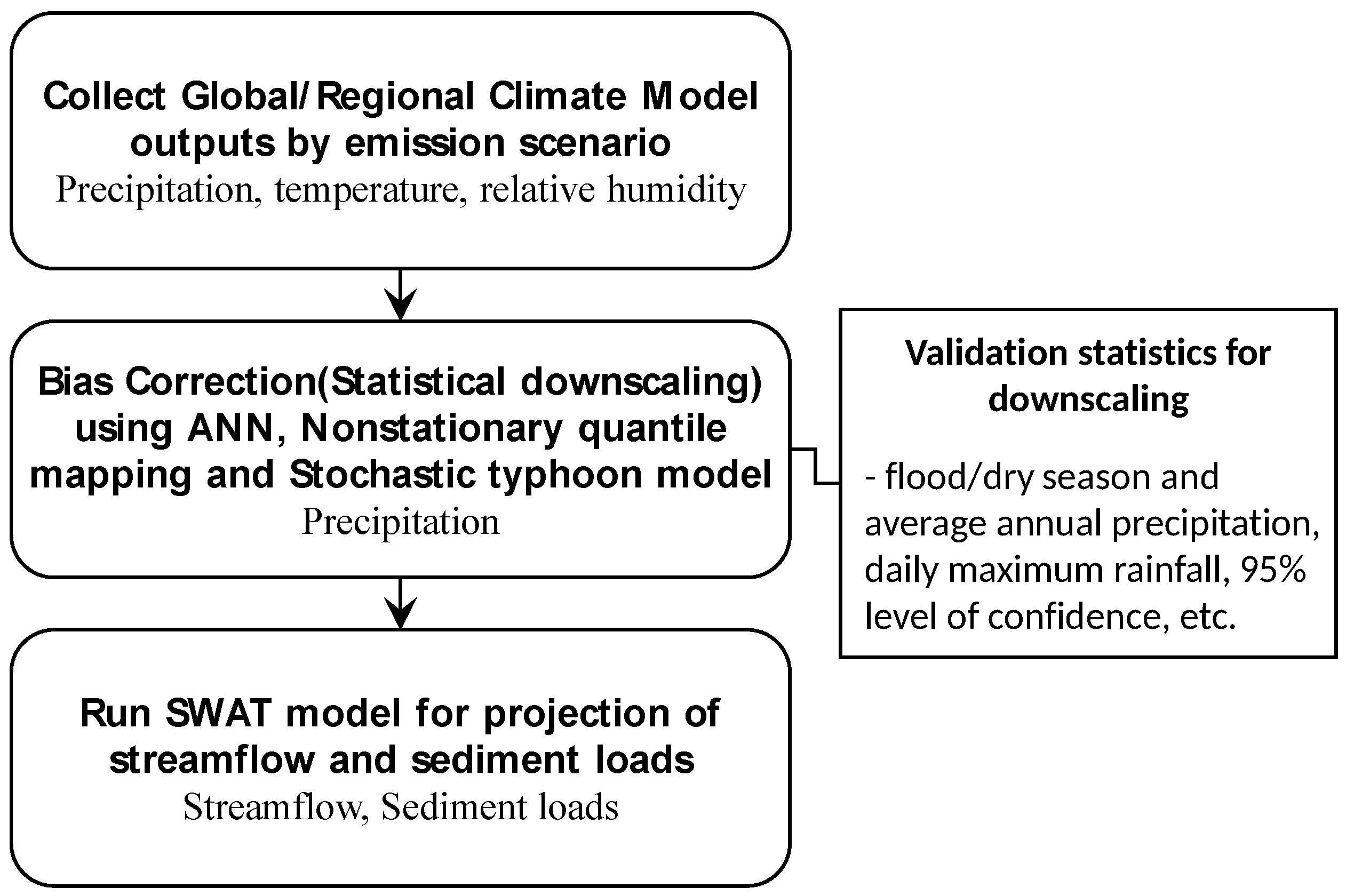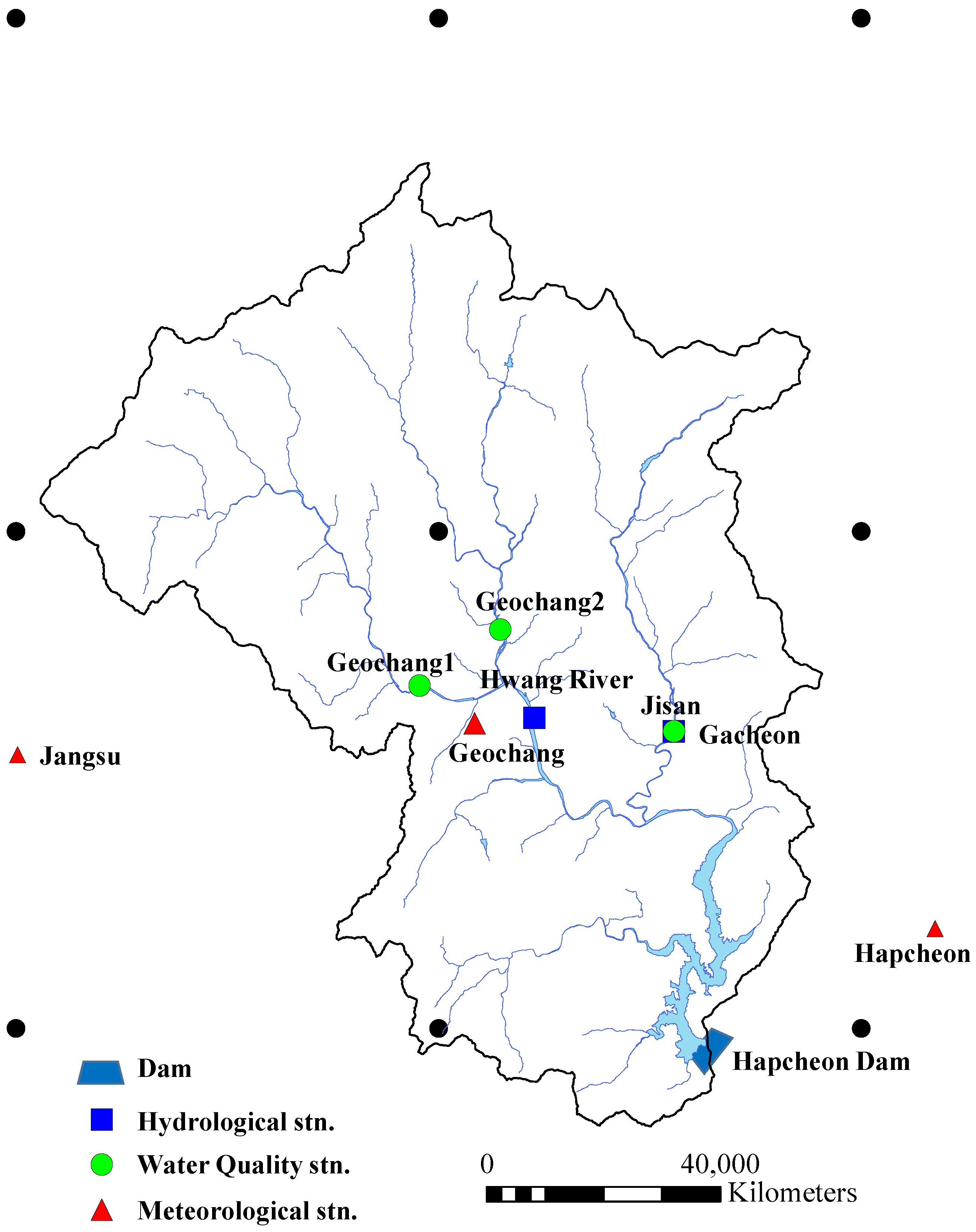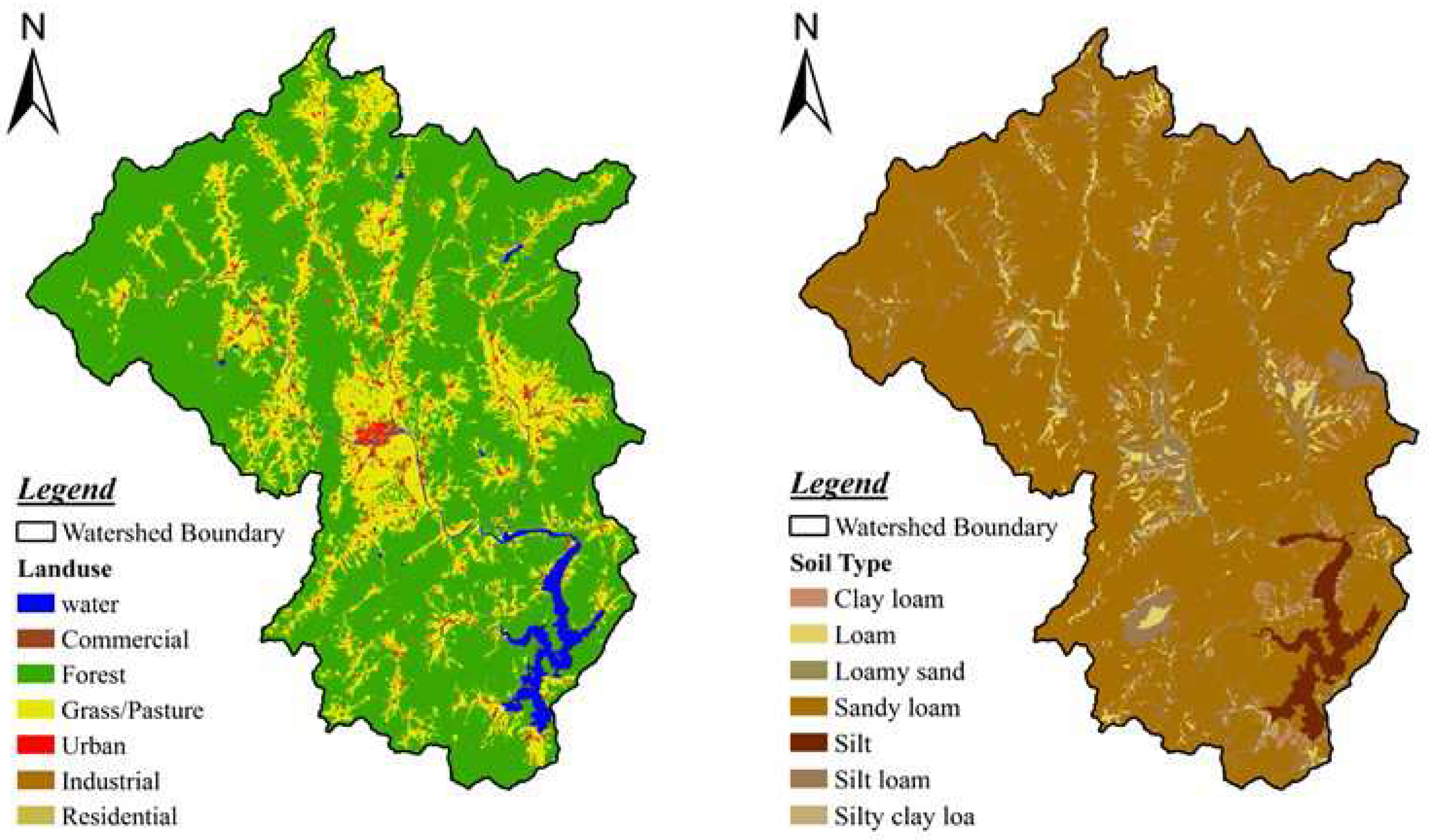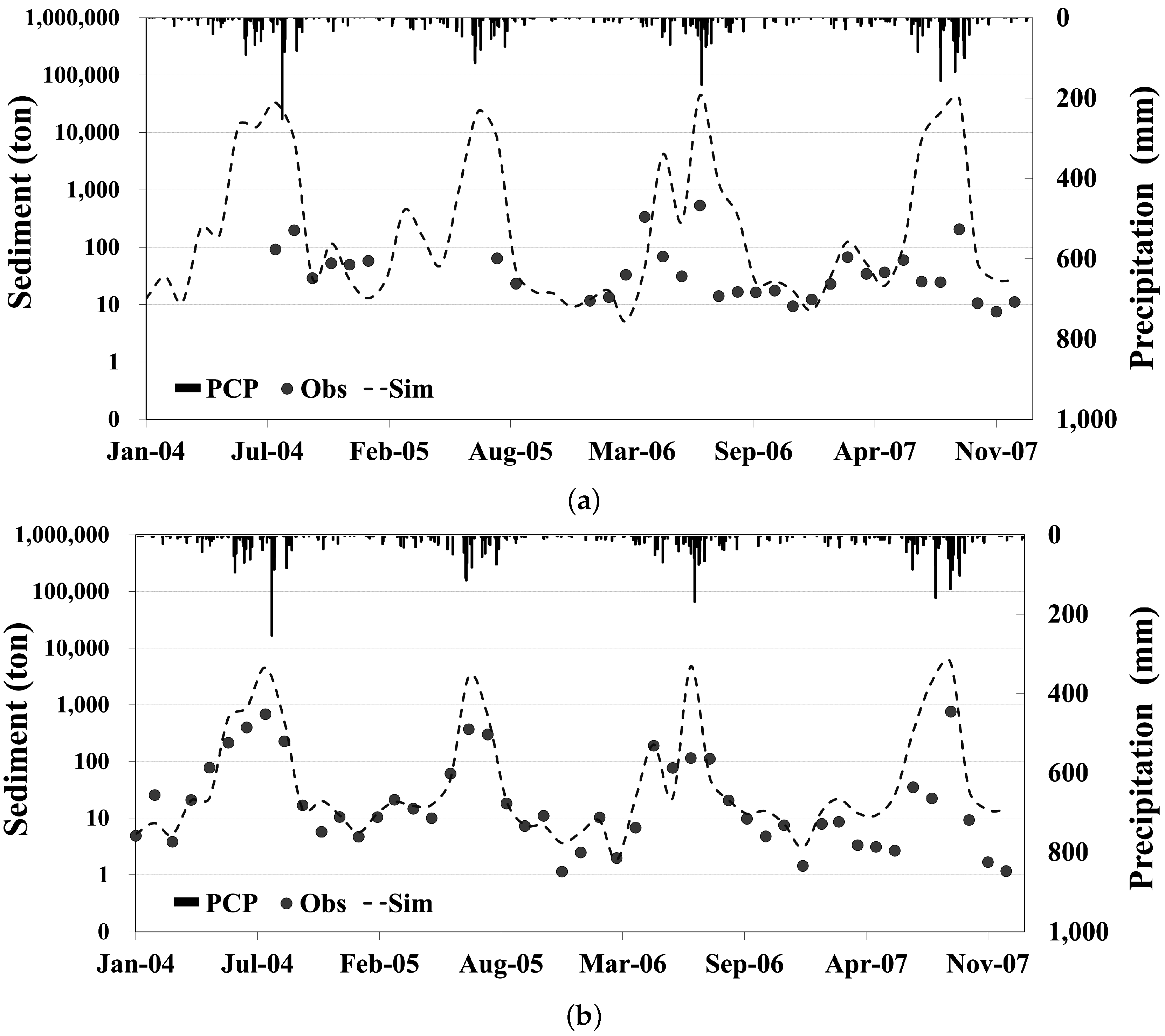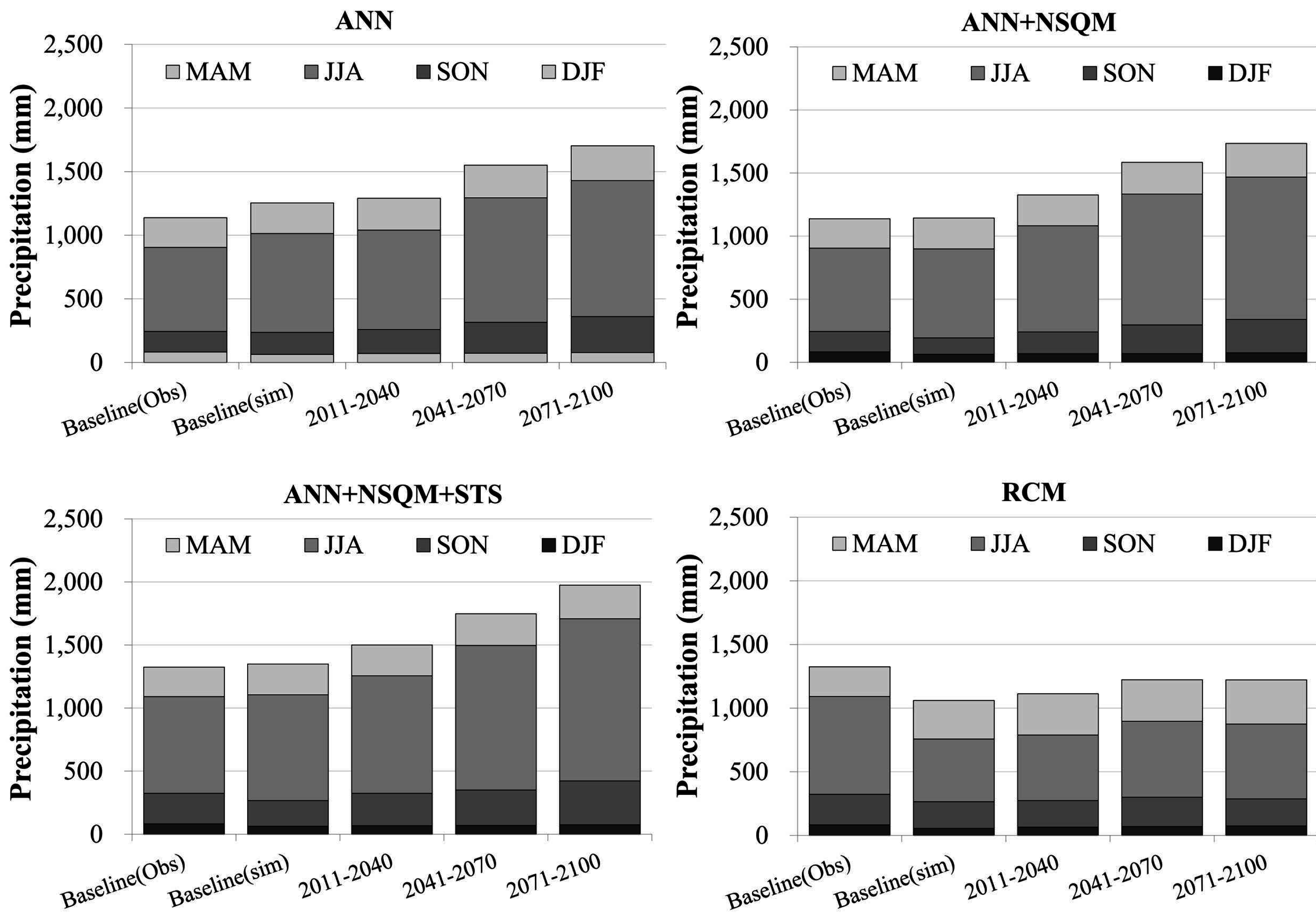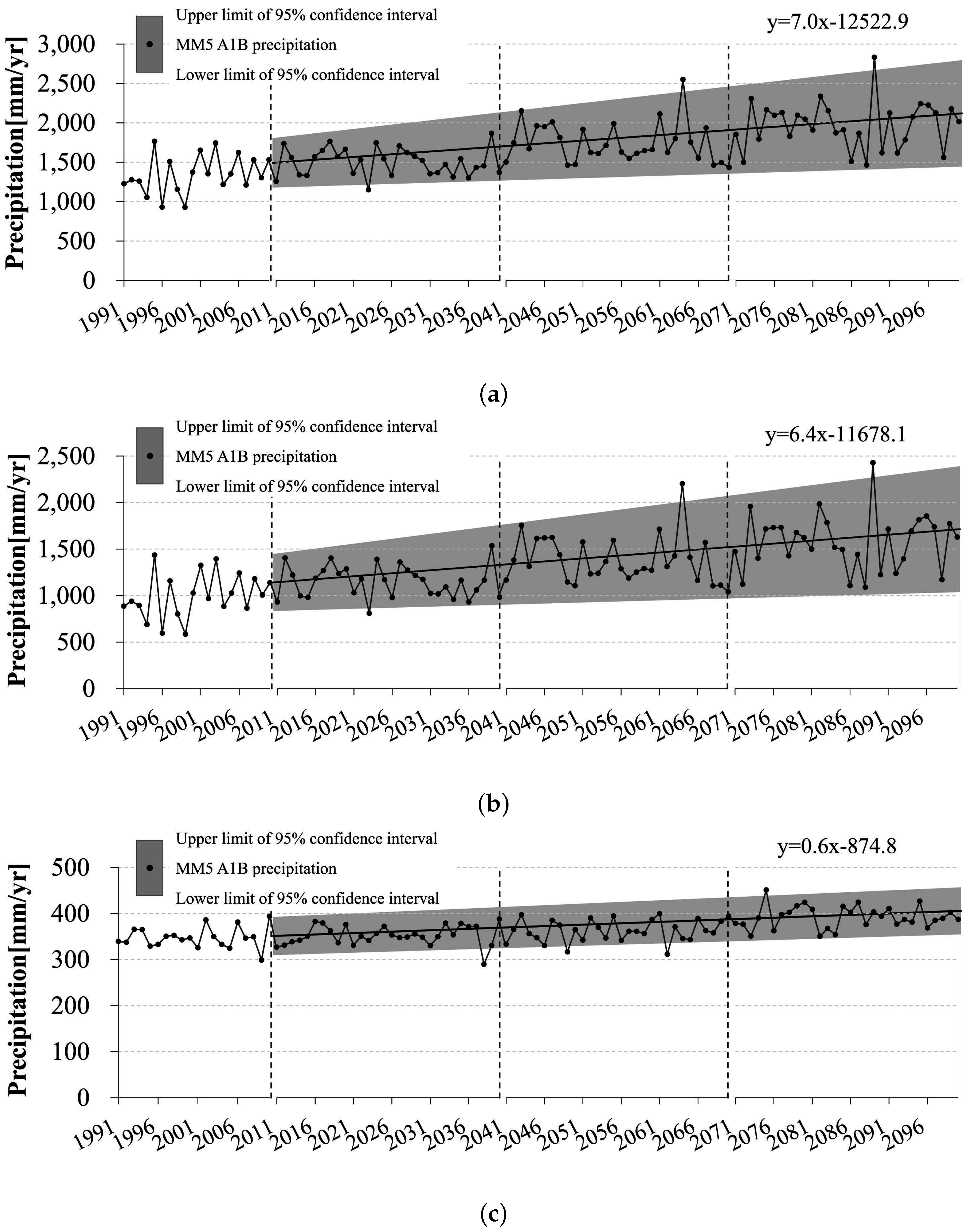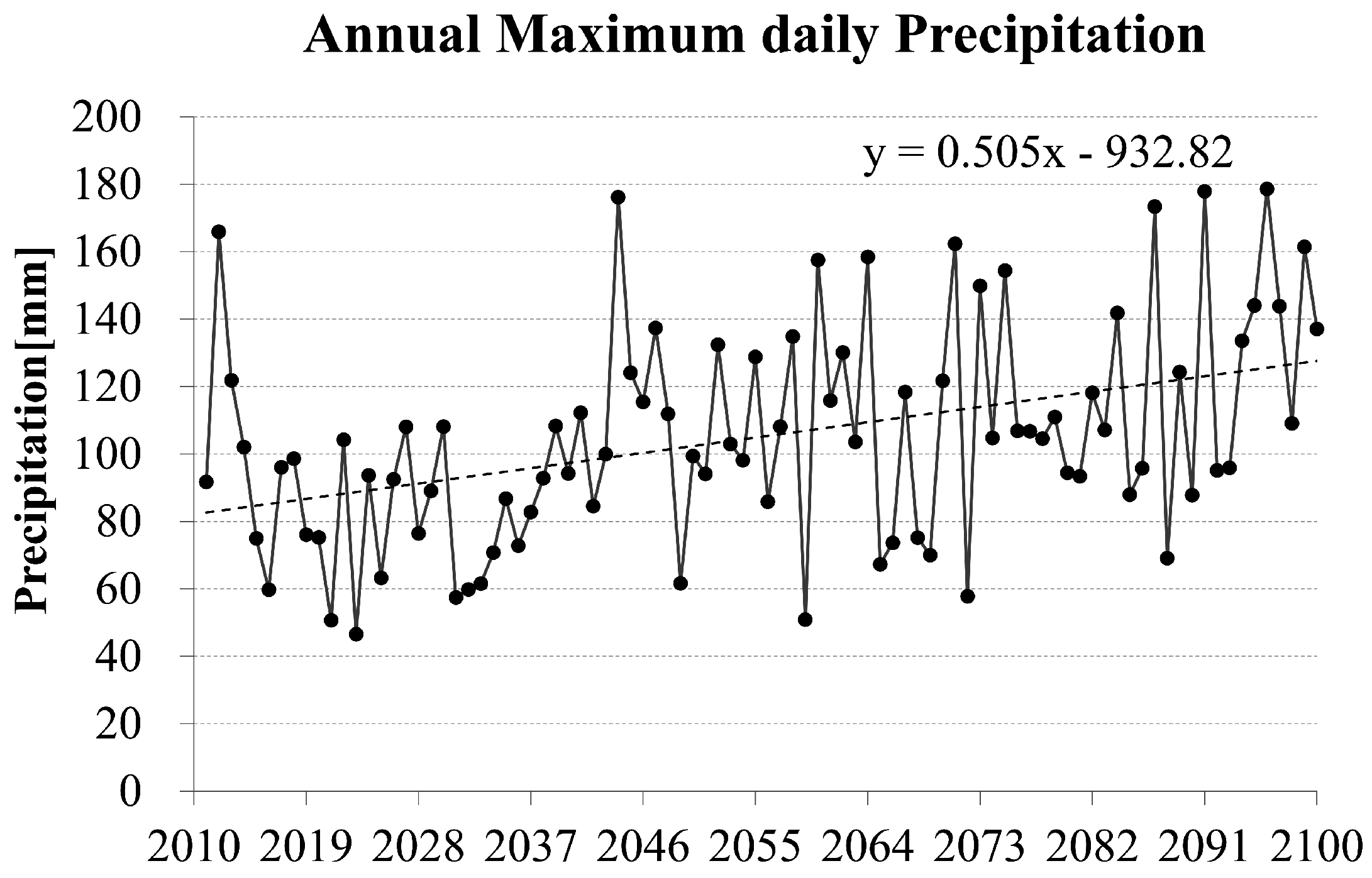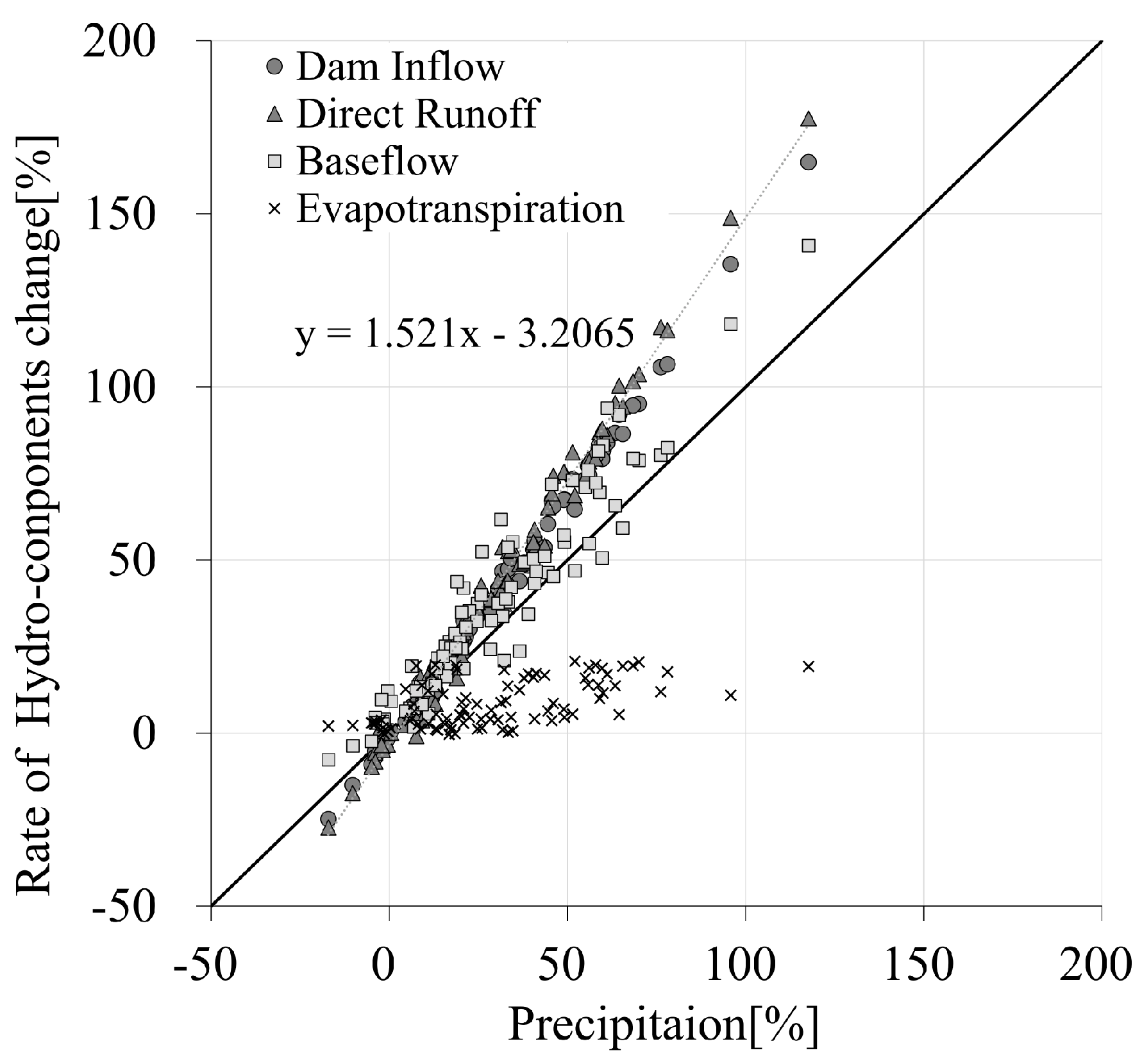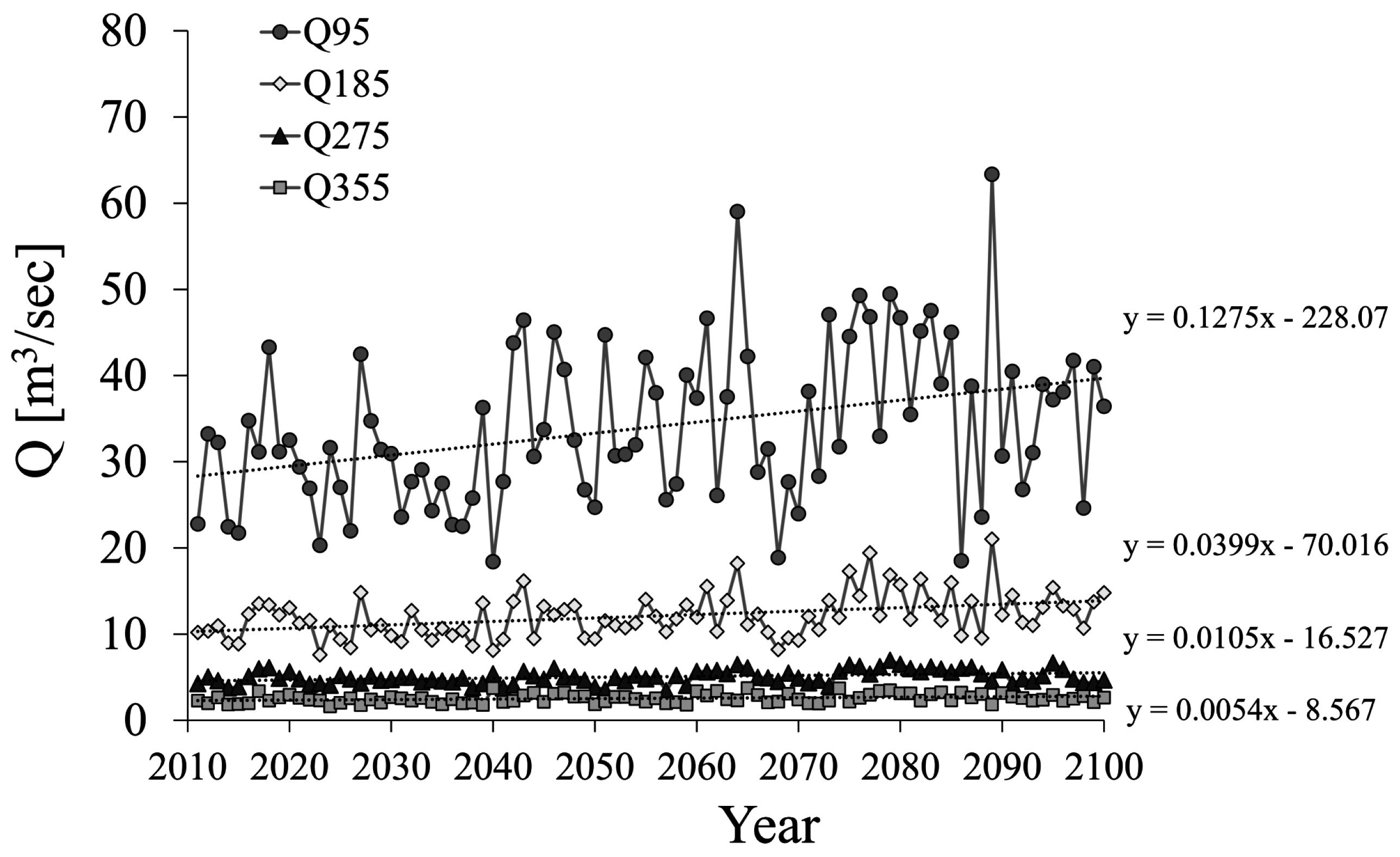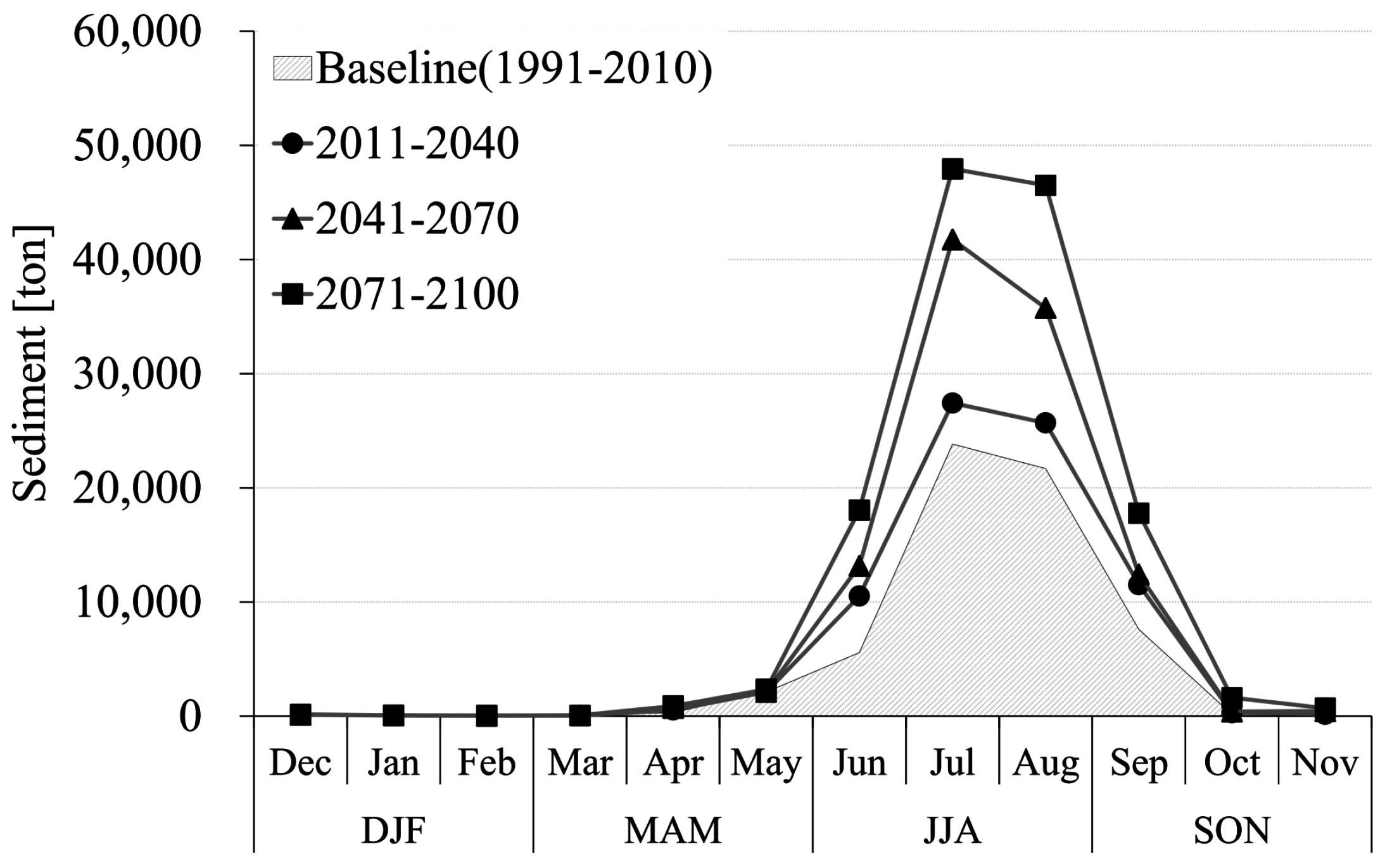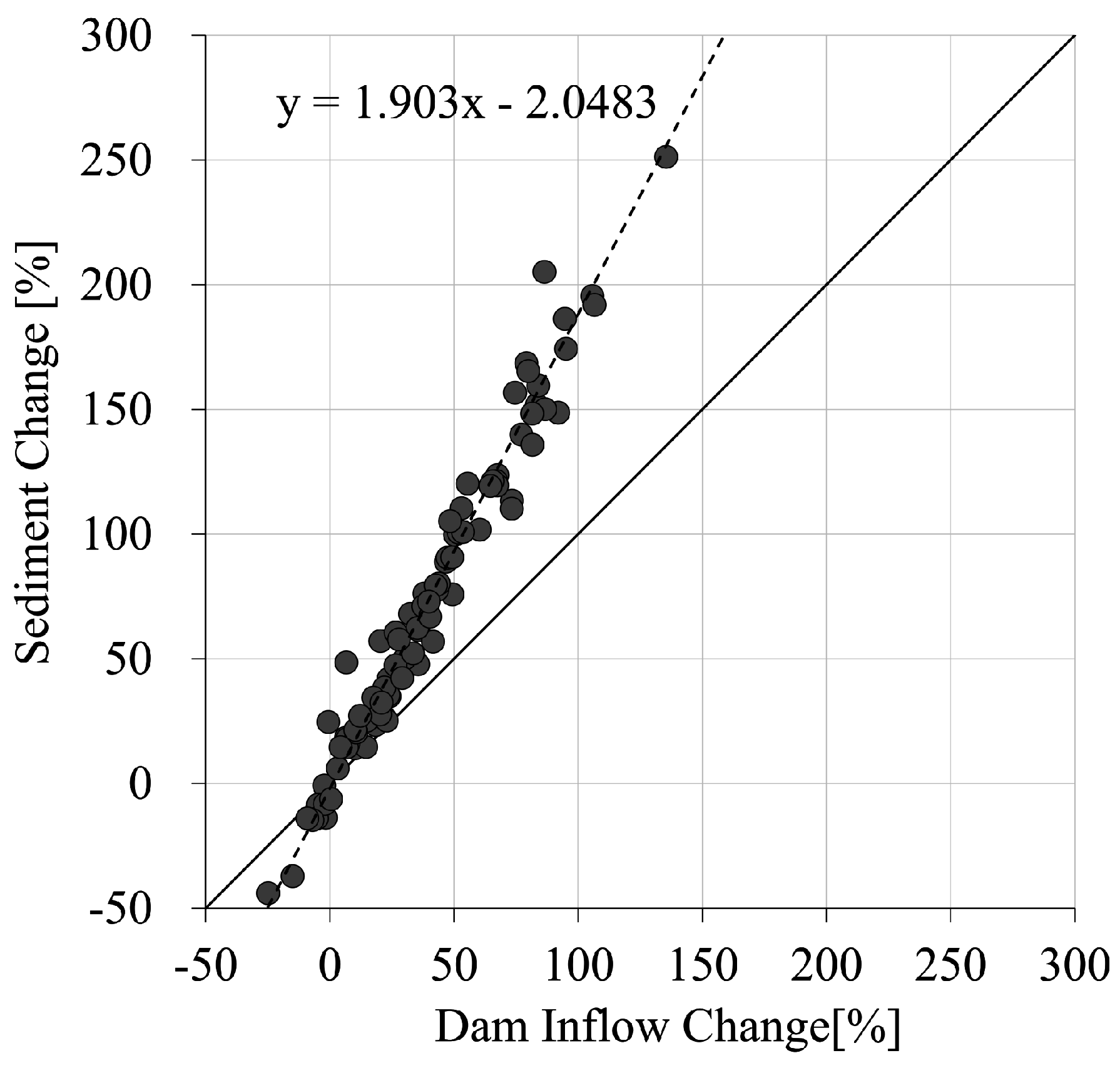1. Introduction
The major consequences of climate change in the Korean peninsula will be upward trends in mean atmospheric temperature and precipitation. The increase in the regional precipitation has been observed in the form of not only total precipitation, but also heavy precipitation events. Kang [
1] reported that between 1973 and 2007, the average daily maximum precipitation increased 105.8 mm (38.5%), and the average occurrence of the storm events over 80 mm/day increased by 1.02 events (61.4%). Pruski and Nearing [
2] found that a change in precipitation amount and intensity had a much greater effect on soil erosion and runoff generation than a change in storm frequency. The eroded sediments and sediment-bound chemicals from non-point sources, in particular, can enter the surface water system, resulting in long-term eutrophication and toxification [
3].
However, the climate change impacts on erosion, sediment transport and deposition have been dealt with as research topics only recently. The primary limitation of soil erosion prediction under the climate change scenario is the spatial-temporal scale of available outputs Michael [
3] and the Global Climate Model’s (GCM’s) limited capability of reproducing local extreme storm events and tropical cyclones, e.g., typhoon events.
Under the similar precipitation scenario, the impacts on sediment runoff show a different regime. In the New York City water supply watershed, the sediment yield is more significant during the winter season due to a shift in the timing of snowmelt (Mukundan et al., 2013). In most regions, a variation (increase/decrease) in future precipitation leads to the resultant same variation in soil erosion [
4,
5]. In spite of the increase of future summer precipitation, sediment yield during the summer season was predicted to decrease owing to an increase in soil moisture deficit and evapotranspiration, meaning an increase in precipitation loss [
6]. In the case of central Oklahoma, U.S., the rate of increase in sediment runoff is revealed to depend more on the variability of precipitation. Even though the total annual precipitation increases in the future, the sediment runoff is expected to increase owing to the increased variability of precipitation, and the rate of increase in sediment was amplified compared with that in precipitation [
7]. Asselman et al. [
8] found that the sediment in the entire basin will increase in the future, but upstream and downstream reaches show different regimes, not only in the rate, but also in the increase or decrease due to the effectiveness of sediment delivery along the river courses.
Coupling hydro-climatic components with the physical process for sediment runoff is a key module for obtaining reliable projection. A few examples of coupling processes are the mechanistic understanding of the spatial and temporal evolution of the hydrodynamical sediment transport process and volumetric changes in suspended sediment and bedload [
9]; dynamic interactions and feedbacks between the terrestrial biosphere and the water cycle [
10]; experimental findings for the relationship between nutrient export and rainfall or runoff time distribution [
11]. Typhoon rainfall is one of the major sources of total precipitation, and it occupies 10%–20% of the total annual precipitation in Korea. Because of the relatively low grid resolution and possible regional biases of GCM output, the model chain between GCM and any hydro-environmental impact model requires downscaling and bias correction of the GCM output. The target scale is determined according to the type of model combination. The Model Output Statistics (MOS) is a typical method for post-processing large-scale GCM outputs and subsequently obtaining regional and/or local climate information [
12]. It is based on multiple regression analyses between the predictand (e.g., regional and/or local climate information) and available predictors (GCM output). A number of linear and nonlinear MOS techniques have been used to post-process numerical weather prediction model outputs, including generalized additive models [
13], self-learning algorithms (e.g., [
14]) and models based on the Artificial Neural Network (ANN) [
15,
16,
17,
18,
19,
20].The ANN model is one of the nonlinear regression methods and is considered as relatively straightforward, providing solutions are readily available within the full range of available predictor variables.
In this study, for the purpose of the reliable prediction of sediment yield in the watershed, the fine-scale projections for hydro-climate components were obtained first using the statistical bias correction and downscaling scheme based on the combination of ANN, Nonstationary Quantile Mapping (NSQM) and Stochastic Typhoon Synthesis (STS) sub-modules. Successively, the hydrologic runoff and sediment yield from the land surfaces were predicted through the long-term continuous watershed model, SWAT, using the bias-corrected and downscaled Regional Climate Model (RCM) output under the Intergovernmental Panel on Climate Change’s (IPCC’s) A1B climate change scenario.
3. Statistical Downscaling: Overview
In order to produce the downscaled future projection of bias-corrected precipitation, a model chain of the ANN, NSQM and STS sub-modules was applied to the GCM precipitation output. The ANN is one of the Model Output Statistics (MOS) tools for correcting regional biases embedded in RCM or GCM [
23,
24]. The predictor variables for input to the ANN are precipitable water, relative humidity and temperature (average, minimum and maximum). In order to obtain improved modeling performance, the ANN structure was constructed separately for the flood (June–October) and non-flood (November–May) seasons. Additional data fitting was implemented with NSQM, which utilizes the temporally-varying statistical parameters reflecting the temporal trend captured by the original RCM and thus provides a more realistic projection with seamless connection with the baseline scenario fitted to the historical observation. The GCM or RCM does not include the local heavy rainfall and typhoon generation mechanism, which can be a reason for the underestimation of the summer precipitation [
25]. Recently, Murakami et al. [
26] developed a typhoon projection technique with high-resolution MRI-AGCMon a 20-km scale and applied it for an ensemble projection using the same model on a 60-km scale. However, the ensemble experiments with 60-km resolution MRI-AGCMs show large uncertainties in the projection of regional tropical cyclone changes. The developers claimed that future changes in the spatial distribution of Sea Surface Temperature (SST) are a major source of uncertainty in terms of future changes in the magnitude and frequency of tropical cyclones. The typhoon rainfall was simulated separately for the projection period, utilizing the STS sub-module, which generates the occurrence (and duration) and intensity of the typhoon using the mixed Poisson and Gumbel distribution, respectively [
27]. In this study, in the process of producing the hydro-climate scenario with typhoon rainfall, the ANN training was carried out after eliminating the typhoon events that occurred during the flood season; the separately-simulated typhoon rainfall was then superimposed on the downscaled GCM output (
Figure 3). The additional bias correction was implemented using the NSQM for the target probability density function with parameters varying consistently with the original GCM output. The periods of ANN training, validation and projection are 1991–2005, 2006–2010 and 2011–2100, respectively.
3.1. Statistical Downscaling: Artificial Neural Network Sub-Module
The ANN model is one of the popular nonlinear prediction models based on learning from the existing dataset. Applications of ANN in the atmospheric sciences have been reviewed by Gardner and Dorling [
28] and others in the references for this current work. A number of additional research works have also been carried out in the areas of post-processing of numerical weather forecasting [
24], precipitation forecasting [
29], tornado warning [
30], infilling missing daily weather records [
31], weather forecasting [
32], etc. Among them, Hall et al. [
30]’s model was developed as part of the modernization of the National Weather Service (NWS) in the USA for the purpose of the local generation of Quantitative Precipitation Forecasts (QPFs) and their subsequent use in hydrological models at River Forecast Centers. Their model consists of two sub-networks of the Probability of Precipitation (PoP) network for the occurrence of precipitation and QPF for the amount of precipitation. As a daily network model for weather forecast, the PoP sub-network was necessary in advance of running the QPF model in order to enhance the model’s performance. However, the monthly ANN model outperformed the daily model because the random variability of the daily model is dominant over the periodic seasonal variation. In this study, the monthly ANN model was developed for downscaling the GCM precipitation output. Unlike the daily forecast model with its intermittent temporal occurrence, the monthly model allows the single module of QPF without the need to precede with the use of the PoP sub-module.
The QPF network was developed to predict monthly areal precipitation covering the Hapcheon dam basin area of 928.9 km
2 using the predictors of precipitable water, relative humidity and temperature (average, minimum, maximum) provided as the GCM output. The neural network has a three-layered feed-forward structure: signals flow forward from input layer neurons through any hidden units, eventually reaching the output neurons. Because the ANN scheme is a type of mapping for the weighted linear sum of predictor variables and the bias term through the activation function, the resulting output can appear as a negative value. The negative value can be avoided by, for example, taking a logarithm of the variables under consideration, if the hydrologic variables are positive values (i.e., precipitation or surface runoff). Prior to running the transformed neural network models, all of the inputs and outputs under consideration must be scaled to the network range bounded by the activation function. The activation function is usually selected to be a continuous and bounded nonlinear transfer function. The sigmoid function used in this study has the following form:
where
. Note that
is bounded on (0, 1).
The input layer consists of
units, each of which receives one of the input variables. The so-called hidden layer is composed of
units (i.e., neurons). Mathematically, a three-layer ANN can be written for each season as:
where:
: the log-transformed input to unit i of the input layer
, where : the number of inputs
, where : the number of hidden units
: the parameters, or weights, controlling the strength of the connection between the input unit i and the hidden unit h
and : the thresholds
: the parameters controlling the strength of the connection between the hidden unit h
f: the activation or transfer function
3.2. Statistical Downscaling: Nonstationary Quantile Mapping Sub-Module
Most GCM and RCM generally show overall underestimation and regional biases, which should be restored or removed before being used for the impact model. Their ability to capture local/regional scale patterns of mean, variability, spatial-temporal correlation and extreme values that are directly relevant to the interests of the end users for hydrologic design and mitigation strategy planning is less promising, especially for precipitation (e.g., [
33]). In general, the post-processing of bias correction can be classified into six methods, including the linear scaling, local intensity scaling, power transformation, variance scaling, distribution transfer and delta-change approach [
34]. Among these methods, the distribution transfer method adjusts the systematic biases through mapping the Cumulative Distribution Function (CDF) of the model simulation into the target CDF of the observation or transformed observation [
35], which is alternatively called “quantile mapping”, which is classified into the stationary and nonstationary parameter model.
where
F is the CDF of either the observations or the model.
y(
t) is the original value, and
is the bias-corrected value for a specific month (
t).
The Gammadistribution [
36] with shape parameter
α and scale parameter
β is often assumed to be suitable for distributions of precipitation events:
where
,
3.3. Statistical Downscaling-Stochastic Typhoon Simulation Sub-Module
Generally, GCM and RCM are incapable of capturing the outbreak and development of a typhoon progressing at their sub-grid scale. In the calculated area affected hydrologically by the typhoon, the mathematically-generated typhoon rainfall should be included to meet the realistic total amount. In this study, the typhoon rainfall to be superimposed onto the downscaled GCM output was simulated for the projection period using the STS, which generates the occurrence (inter-arrival time) and magnitude of the typhoon rainfall using the mixed Poisson and Gumbel distribution, respectively (Moon, et al., 2012). The number of mean monthly typhoon occurrences during the flood season (June–October) was simulated using the Poisson distribution.
where:
i: specific month (June–October)
: number of occurrences during the specific month
: mean number of occurrences during the specific month
A number of research works have been carried out for the proper distribution of extreme precipitation events. The total amount, duration and intensities of tropical cyclone events showed typically skewed distributions of Gamma, Gumbel, Log-Pearson Type III, etc. [
25,
37,
38]. The national probability map [
39] of Korea was produced based on the Gumbel distribution, which was feasible for extreme storm events in most areas. The same distribution was adopted in “the guideline of design flood estimation [
40]”. In this study, the Gumbel and its inverse function were applied using Equations (6) and (7). Assuming the temporal stationarity of the tropical cyclone during the projection period (2011–2100), the parameter of the monthly number of occurrences and the mean amount of rainfall for individual events were estimated using the year book on Korean tropical cyclones [
41]. Using the uniformly-distributed random numbers and associated composite distributions, the monthly typhoon rainfall amounts were projected for the period of 2011–2100, preserving the stochastic performance during the past 20 years of the baseline period.
6. Conclusions
The hydro-environmental impact in the context of sediment yield associated with basin runoff was evaluated using the SWAT model under IPCC’s climate change scenario. The precipitation projection was based on the RCM MM5 model output under the AR4 A1B scenario and was downscaled statistically using the combination of ANN, nonstationary quantile mapping and the stochastic typhoon simulation model. Through separating the typhoon rainfall out and the use of the monthly accumulated rainfall for training and validation, the performance of ANN modeling could be improved. In order to reproduce the temporally-varying trend reflecting climate change, quantile mapping with temporally-varying parameters of the target distribution was applied. Considering that realistic simulation of sediment yield is closely related to the rainfall event with high intensity and frequency, the typhoon rainfall was simulated separately. The incremental improvement of the combined downscaling process was evaluated successfully during the baseline period, which provides projected confidence for the simulated future scenario.
The basin scale long-term runoff and sediment yield according to various soil and land use types were computed using the physically-based semi-distributed continuous rainfall-runoff model, SWAT. The calibration was implemented sequentially from the HRUs in the upstream area to the basin outlet. From a practical point of view, the water quality monitoring network has a lack of density, observation cycle and available periods, which renders reliable calibration and validation of sediment yield difficult. Accordingly, the modeling performance was evaluated for the monthly accumulated amount rather than using a comparison of the directly continuous daily simulations with the eight-day interval observations. The biases possibly occurred because the surface runoff gauging station and the water quality monitoring station are located apart. The biases were corrected considering the area correction factor. The ANN modeling was implemented separately for the flood (June–October) and non-flood (November–May) seasons. The training, validation and projection were carried out during the periods of 1991–2005, 2006–2010 and 2011–2100, respectively. The projection results were illustrated for 30-year periods of FFS (2011–2040), MFS (2041–2070) and LFS (2071–2100). The land use and vegetation changes during the projection periods were not considered. The projection for annual precipitation shows 25.7% and 57.2% increases with respect to the baseline period by 2040 and 2100, respectively. In particular, the increasing rate (33.4% and 72.5%) during the flood season is much higher than that for the annual total amount. However, the sediment yield is expected to increase by 27.4% and 121.2% during the same periods, which exhibits steeper trends than the hydrologic runoff. The relative change of sediment yields is 1.9-times higher than the dam inflows.
As introduced in the section of the literature review, the results in this study were compared qualitatively with additional recent case studies in various regions of America, Europe, India and China. Under a similar precipitation scenario, the impacts on sediment runoff show different regimes. The quantitative rate of increase or decrease largely depends on climate change scenarios and spatio-temporal scales, input data quality, etc. Even though there is still insufficient understanding of the nonlinear relationship between rainfall intensity and sediment detachment from the land surface, the above results indicate the need for preparing countermeasures for protecting basin land surfaces from soil loss and their impacts on ecosystems. Effectively integrated water resources management could be achieved through the reliable assessment of regional vulnerability against potential impacts under climate change.
